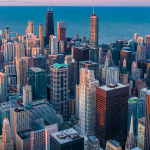As cities strive to reduce carbon emissions and mitigate climate change, renewable energy sources like solar power are playing an increasingly vital role. In this blog, we explore the benefits of solar energy in urban settings and innovative solutions for integrating solar technology into the built environment.
1. Sustainable Power Generation:
Solar energy offers a clean and sustainable alternative to traditional fossil fuels, helping cities reduce their carbon footprint and transition to a low-carbon energy future. By harnessing the power of the sun, urban areas can generate electricity with minimal environmental impact, mitigating air pollution and combating climate change.
2. Rooftop Solar Installations
One of the most common applications of solar technology in urban environments is rooftop solar installations. By installing solar panels on rooftops of residential, commercial, and industrial buildings, cities can harness solar energy to power homes, businesses, and public facilities, reducing reliance on grid-supplied electricity and lowering utility bills for residents.
3. Solar Parks and Community Solar Gardens
In addition to rooftop installations, cities can develop solar parks and community solar gardens to expand access to solar energy for residents who may not have suitable rooftop space. These centralized solar facilities provide shared access to clean energy, allowing individuals and communities to benefit from solar power without the need for individual installations.
4. Building-Integrated Photovoltaics (BIPV)
Building-integrated photovoltaics (BIPV) integrate solar panels seamlessly into the building envelope, serving as both energy generators and architectural elements. BIPV systems can be incorporated into facades, windows, and canopies, blending aesthetics with functionality to enhance the visual appeal of urban structures while harnessing solar energy.
5. Solar-Powered Street Lighting
Solar-powered street lighting systems offer an energy-efficient alternative to traditional grid-connected streetlights, reducing electricity consumption and operating costs for municipalities. These standalone lighting solutions use photovoltaic panels to capture solar energy during the day and store it in batteries for nighttime illumination, enhancing safety and security in urban areas.
6. Solar Water Heating Systems
Solar water heating systems utilize solar thermal collectors to capture sunlight and heat water for residential and commercial use. By installing solar water heaters in buildings, cities can reduce energy demand for water heating, lower utility costs, and decrease reliance on fossil fuels, contributing to a more sustainable urban water infrastructure.
7. Policy and Incentive Programs
To accelerate the adoption of solar energy in urban environments, cities can implement supportive policies and incentive programs that encourage solar installations and facilitate regulatory approvals. These initiatives may include feed-in tariffs, net metering policies, tax credits, and streamlined permitting processes to make solar investments more accessible and affordable for residents and businesses.
Conclusion
Solar energy presents a compelling opportunity for cities to reduce their environmental footprint, enhance energy resilience, and promote sustainable development. By embracing solar solutions in urban environments through rooftop installations, community solar projects, building-integrated photovoltaics, and innovative policy measures, cities can harness the power of the sun to create cleaner, greener, and more resilient urban landscapes for future generations.


